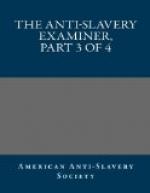“The food of the slaves was generally corn bread, and sometimes meat or molasses.”
Reuben G. Macy, a member of the Society of Friends, Hudson, N.Y., who resided in South Carolina.
“The slaves had no food allowed them besides corn, excepting at Christmas, when they had beef.”
Mr. William Leftwich, a native of Virginia, and recently of Madison Co., Alabama, now member, of the Presbyterian Church, Delhi, Ohio.
“On my uncle’s plantation, the food of the slaves, was corn-pone and a small allowance of meat.”
WILLIAM LADD, Esq., of Minot, Me., president of the American Peace Society, and formerly a slaveholder of Florida, gives the following testimony as to the allowance of food to slaves.
“The usual food of the slaves was corn, with a modicum of salt. In some cases the master allowed no salt, but the slaves boiled the sea water for salt in their little pots. For about eight days near Christmas, i.e., from the Saturday evening before, to the Sunday evening after Christmas day, they were allowed some meat. They always with one single exception ground their corn in a hand-mill, and cooked their food themselves.”
Extract of a letter from Rev. D.C. EASTMAN, a preacher of the Methodist Episcopal church, in Fayette county, Ohio.
“In March, 1838, Mr. Thomas Larrimer, a deacon of the Presbyterian church in Bloomingbury, Fayette county, Ohio, Mr. G.S. Fullerton, merchant, and member of the same church, and Mr. William A. Ustick, an elder of the same church, spent a night with a Mr. Shepherd, about 30 miles North of Charleston, S.C., on the Monk’s corner road. He owned five families of negroes, who, he said, were fed from the same meal and meat tubs as himself, but that 90 out of a 100 of all the slaves in that county saw meat but once a year, which was on Christmas holidays.”
As an illustration of the inhuman experiments sometimes tried upon slaves, in respect to the kind as well as the quality and quantity of their food, we solicit the attention of the reader to the testimony of the late General Wade Hampton, of South Carolina. General Hampton was for some time commander in chief of the army on the Canada frontier during the last war, and at the time of his death, about three years since, was the largest slaveholder in the United States. The General’s testimony is contained in the following extract of a letter, just received from a distinguished clergyman in the west, extensively known both as a preacher and a writer. His name is with the executive committee of the American Anti-Slavery Society.
“You refer in your letter to a statement made to you while in this place, respecting the late General Wade Hampton, of South Carolina, and task me to write out for you the circumstances of the case—considering them well calculated to illustrate two points in the history of slavery: 1st, That the habit of slaveholding dreadfully blunts the feelings toward the slave, producing such insensibility that his sufferings and death are regarded with indifference. 2d, That the slave often has insufficient food, both in quantity and quality.




